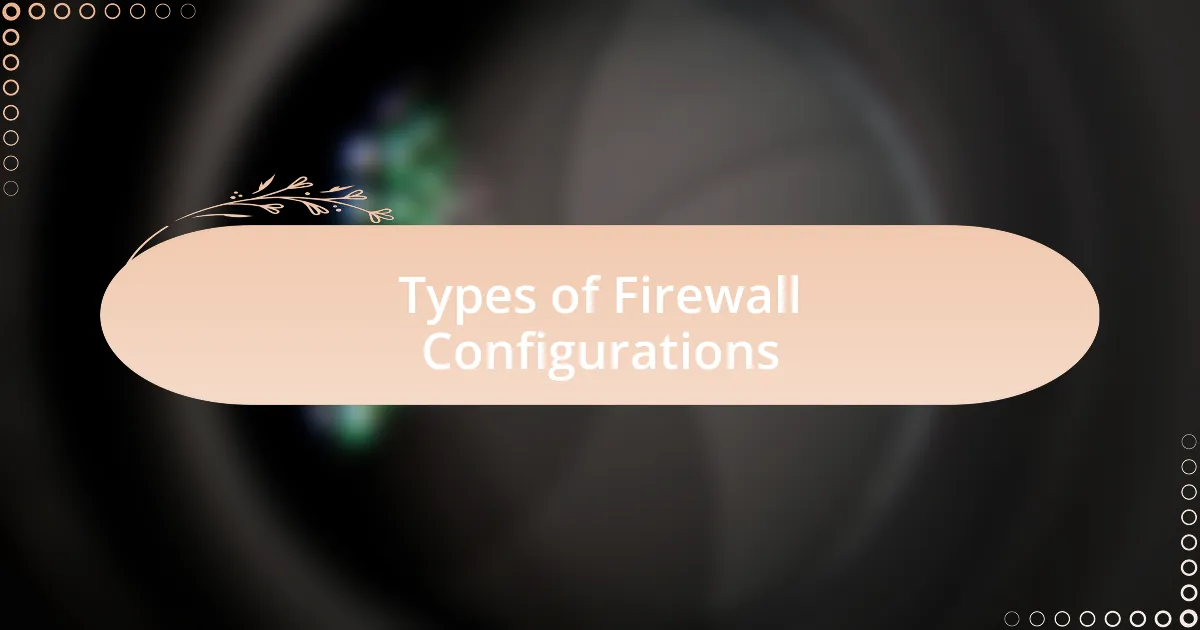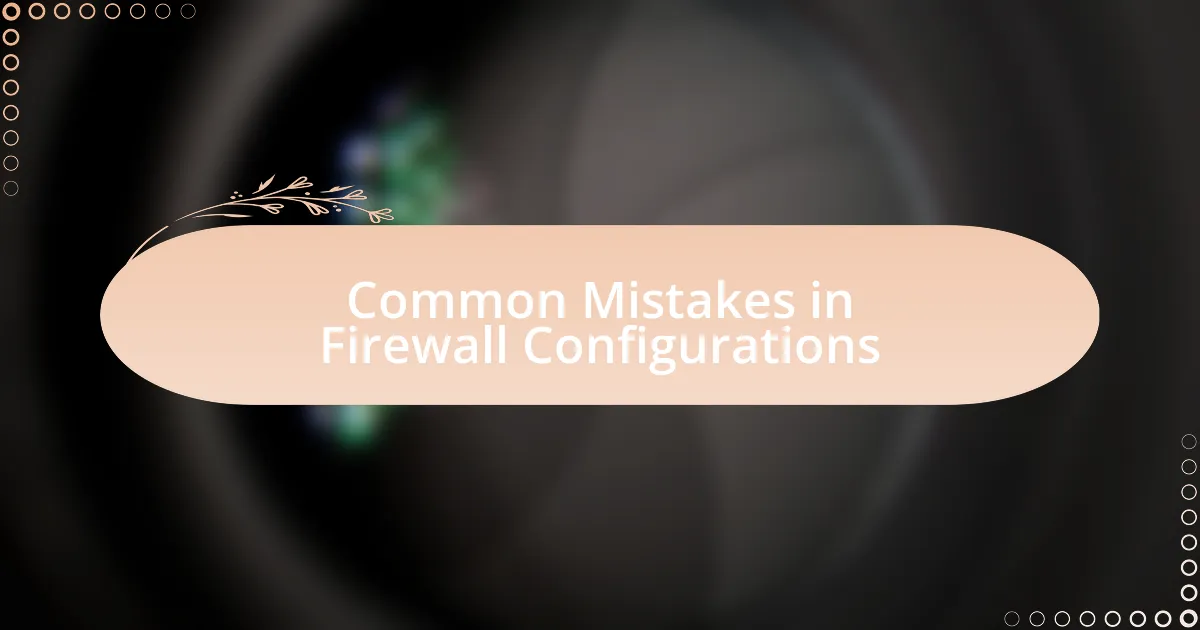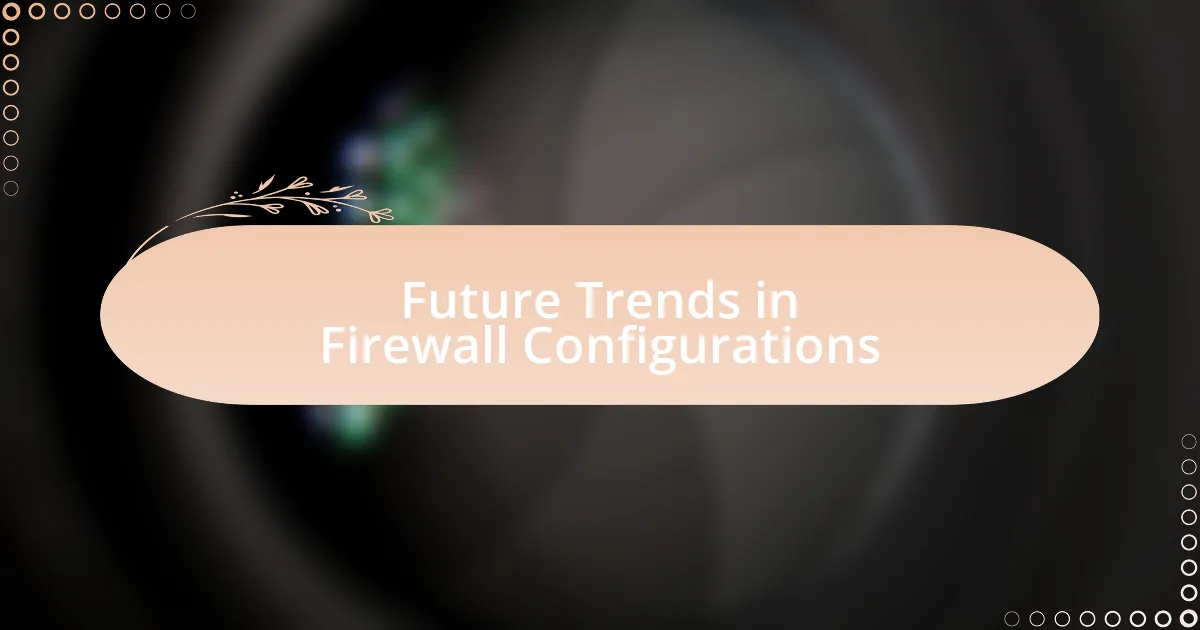Key takeaways:
- Understanding specific network needs and regularly updating firewall rules are crucial for effective firewall configurations.
- Firewalls are essential for data protection, regulatory compliance, and optimizing network performance in telecommunications.
- Implementing the principle of least privilege and monitoring traffic can significantly enhance security while avoiding common configuration mistakes.
- Future trends include AI integration for adaptive security, user-centric firewall configurations, and the seamless merging of traditional and cloud-based security measures.

Understanding Firewall Configurations
When I first started working with firewalls, I found the configurations daunting. It felt like trying to solve a jigsaw puzzle without knowing what the final picture was meant to look like. But as I delved deeper, I realized that understanding the specific needs of a network is key to setting up an effective firewall configuration.
One of the essential aspects of firewall configurations is defining rules that dictate which traffic should be allowed or blocked. For instance, I’ve often encountered situations where a certain application needed access to the internet, but without proper rules, it could expose the entire network to vulnerabilities. It leads me to wonder: how do you balance security with accessibility?
Over time, I learned that testing and reviewing firewall settings regularly is just as crucial as the initial configuration itself. I’ve seen firsthand how outdated rules can lead to security breaches, reminding me of the saying, “A chain is only as strong as its weakest link.” This dynamic nature of firewall configurations keeps me on my toes and constantly learning.

Importance of Firewalls in Telecommunications
In the world of telecommunications, firewalls play a critical role in safeguarding sensitive data. I’ve experienced moments of sheer panic when a potential breach was detected, realizing that without a robust firewall, our confidential communications could unravel in an instant. This reinforces the importance of having a firewall not just as an accessory, but as a fundamental component of our network security strategy.
Firewalls are essential not only for protecting data but also for ensuring compliance with regulations. I remember a project where our team faced hefty fines due to inadequate protection measures. It hit home that firewalls aren’t merely technical barriers; they’re our first line of defense against legal repercussions and loss of reputation. Does your organization have the necessary protections in place to avoid similar pitfalls?
Moreover, I recognize that firewalls help manage bandwidth and optimize performance. There have been instances where bottlenecks in network traffic hindered our operations, and fine-tuning firewall rules made a noticeable difference. It’s fascinating how a well-configured firewall can enhance not just security, but also the efficiency of telecommunications systems. Have you considered how your firewall configuration impacts overall network performance?

Types of Firewall Configurations
Firewalls can be configured in various ways, each offering unique advantages for telecommunications networks. One common configuration is the network firewall, which serves as a barrier between an internal network and external threats. I recall a project where implementing a robust network firewall turned the tide against numerous intrusion attempts, proving that a centralized defense mechanism can be a game-changer.
Another interesting type is the host-based firewall. This is installed on individual devices instead of the network level. I remember helping troubleshoot a situation where one machine was persistently vulnerable; it was a simple host-based firewall that finally locked down the potential entry points. Have you thought about how securing individual devices could enhance your overall protection strategy?
Then there’s the next-generation firewall, which integrates advanced features like deep packet inspection and intrusion prevention. These firewalls go beyond monitoring and blocking by analyzing the content within the traffic. I have seen first-hand how adopting a next-generation firewall not only bolstered security but also gave us invaluable insights into our network activity. This begs the question: are you leveraging the latest technologies to protect your telecommunications infrastructure effectively?

Best Practices for Configuring Firewalls
When configuring firewalls, one of the best practices is to implement the principle of least privilege. This means allowing only the necessary traffic to access specific resources. I recall an instance where an improperly configured firewall left a critical database exposed, leading to unauthorized access. By tightening the rules and restricting access, we significantly reduced the risk of additional breaches. Isn’t it powerful to think that limiting permissions can have such a profound impact on security?
Another essential practice is to regularly update firewall rules and configurations to adapt to evolving threats. I often find that what worked last year doesn’t necessarily hold up today. In one project, we revisited our configurations and discovered outdated rules that opened several vulnerabilities. The act of routinely assessing and adjusting our settings not only bolstered our defenses but also gave me a renewed sense of control over our security posture.
Lastly, monitoring and logging traffic through firewalls can provide invaluable insights into potential threats. In my experience, I have seen teams catch suspicious activity early just by analyzing logs. I remember one incident where quick responses to anomalies led to thwarted attacks that could have escalated into major incidents. Have you considered how vital your firewall’s reporting capabilities are to your overall security strategy?

Common Mistakes in Firewall Configurations
One common mistake I frequently encounter is leaving unnecessary ports open, which is a major risk. The first time I saw this in a client’s network, I was stunned to find multiple services running that weren’t even needed. It’s like leaving your front door wide open and hoping no one walks in—most of the time, they won’t, but it only takes one curious passerby to cause chaos.
Another frequent error involves overly permissive rules that allow too much traffic through. I once stepped into a situation where I found a firewall configuration that was so lenient it resembled Swiss cheese. This not only defeats the purpose of having a firewall but also paints a target on your back for malicious actors. How can we expect to defend our networks if we make it so easy for attackers to slip through?
Lastly, disregarding the importance of documentation can lead to significant issues down the line. In one project, I found myself struggling to untangle a complex configuration due to a lack of clear records. This oversight not only created confusion but also delayed urgent updates. Isn’t it frustrating when something as simple as proper documentation could prevent so many headaches?

My Personal Experience with Firewalls
When I started working with firewalls, my initial approach was pretty basic. I remember configuring a firewall for a small business, feeling confident until I realized too late that I had misconfigured a rule, inadvertently blocking critical communication. The panic I felt when I discovered that employees couldn’t access essential services was a gut punch—everyone was looking to me for a solution, and I had to act fast.
Over time, I’ve learned that each firewall setup teaches me something new about both security and human nature. I recall a project where we were implementing a new firewall, and the team was excited but misjudged user requirements. We were so focused on blocking potential threats that we inadvertently restricted legitimate access for remote workers. I still think about how important it is to balance security with user needs—isn’t that a constant challenge in our field?
One memorable experience happened during a client audit. I identified several outdated firewall rules that had been left untouched for years. Working through that configuration felt like peeling back layers of an onion; I didn’t just find technical problems, but I also saw the apprehension in my client’s eyes as they realized how vulnerable they had been. That moment hit home for me—the impact of a well-configured firewall isn’t just technical; it’s about trust and the reassurance that their data is protected.

Future Trends in Firewall Configurations
As we look toward the future of firewall configurations, I can’t help but feel a sense of excitement about the integration of artificial intelligence. Picture this: a firewall that learns from network patterns and adapts automatically to potential threats. I remember discussing with a colleague how real-time learning could have changed the way we approached threat detection in the past. Wouldn’t it have been a game-changer?
Moreover, with the rise of remote work, I foresee a shift toward more adaptive, user-centric firewall configurations. Cybersecurity isn’t just about locking doors; it’s about understanding who needs access and when. I once consulted for a company transitioning to a fully remote model, and the need for flexibility in firewall rules was paramount. Reflecting on that experience, I realize how essential it will be for future firewalls to not only secure but also empower users.
Lastly, cloud integration is becoming increasingly significant in firewall architecture. When I was involved in a migration project, we faced challenges connecting on-premises firewalls with cloud security measures. It was eye-opening to see how critical it is to align security postures to maintain comprehensive protection. How will we meet this challenge going forward? I believe that forging seamless connections between traditional and cloud-based technologies will define the next generation of firewall configurations.